Easy Analytic Software
Table of Content
1) What are data analyst tools?
2) The best 14 data analyst tools for 2022
3) Key takeaways & guidance
To be able to perform data analysis at the highest level possible, analysts and data professionals will use tools and software that will ensure the best results in several tasks from executing algorithms, preparing data, generate predictions, automate processes, to standard tasks such as visualizing and reporting on the data. Although there are many of these solutions on the market, data analysts must choose wisely in order to benefit their analytical efforts. That said, in this article, we will cover the best data analyst tools and name the key features of each based on various types of analysis processes. But first, we will start with a basic definition and a brief introduction.
Data analyst tools is a term used to describe software and applications that data analysts use in order to develop and perform analytical processes that help companies to make better, informed business decisions while decreasing costs and increasing profits.
In order to make the best possible decision on which software you need to choose as an analyst, we have compiled a list of the top data analyst tools that have various focus and features, organized in software categories and represented with an example of each. Let's get started.
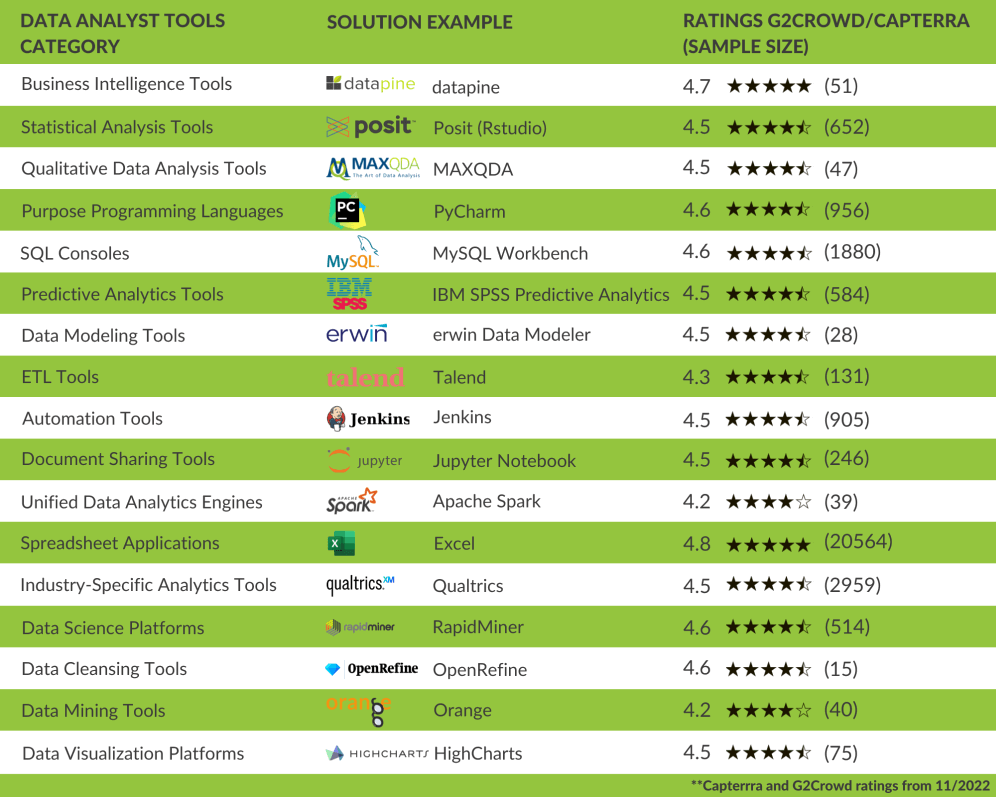
To make the most out of the infinite number of software that is currently offered on the market, we will focus on the most prominent tools needed to be an expert data analyst. The image above provides a visual summary of all the areas and tools that will be covered in this insightful post. These data analysis tools are mostly focused on making analyst's life's easier by providing them with solutions that make complex analytical tasks more efficient. Like this, they get more time to perform the analytical part of their job. Let's get started with business intelligence tools.
1. Business intelligence tools
BI tools are one of the most represented means of performing data analysis. Specializing in business analytics, these tools will prove to be beneficial for every data analyst that needs to analyze, monitor, and report on important findings. Features such as self-service, predictive analytics, and advanced SQL modes make these solutions easily adjustable to every level of knowledge, without the need for heavy IT involvement. By providing a set of useful features, analysts can understand trends and make tactical decisions. Our data analytics tools article wouldn't be complete without business intelligence, and datapine is one example that covers most of the requirements both for beginner and advanced users. This all-in-one tool aims to facilitate the entire analysis process from data integration and discovery to reporting.
datapine
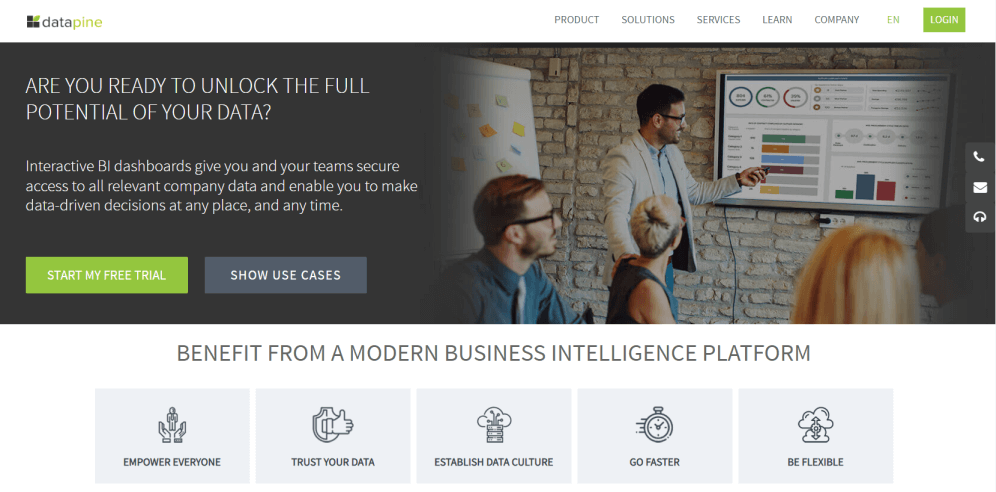
KEY FEATURES:
Visual drag-and-drop interface to build SQL queries automatically, with the option to switch to, advanced (manual) SQL mode
Powerful predictive analytics features, interactive charts and dashboards, and automated reporting
AI-powered alarms that are triggered as soon as an anomaly occurs or a goal is met
datapine is a popular business intelligence software, that is focused on delivering simple, yet powerful analysis features into the hands of beginners and advanced users that need a fast and reliable online data analysis solution for all analysis stages. An intuitive user interface will enable you to simply drag-and-drop your desired values into datapine's Analyzer and create numerous charts and graphs that can be united into an interactive dashboard. If you're an experienced analyst, you might want to consider the SQL mode where you can build your own queries or run existing codes or scripts. Another crucial feature is the predictive analytics forecast engine that can analyze data from multiple sources which can be previously integrated with their various data connectors. While there are numerous predictive tools out there, datapine provides simplicity and speed at its finest. By simply defining the input and output of the forecast based on specified data points and desired model quality, a complete chart will unfold together with predictions.
We should also mention robust artificial intelligence that is becoming an invaluable assistant in today's analysis processes. Neural networks, pattern recognition, and threshold alerts will alarm you as soon as a business anomaly occurs or a previously set goal is met so you don't have to manually analyze large volumes of data – the data analytics software does it for you. Access your data from any device with an internet connection, and share your findings easily and securely via dashboards or customized reports for anyone that needs quick answers to any type of business question.
2. Statistical Analysis Tools
Next in our list of data analytics tools comes a more technical are related to statistical analysis. Referring to computation techniques that often contain a variety of statistical techniques to manipulate, explore, and generate insights, there exist multiple programming languages to make (data) scientists' work easier and more effective. With the expansion of various languages that are today present on the market, science has its own set of rules and scenarios that need special attention when it comes to statistical data analysis and modeling. Here we will present one of the most popular tools for a data analyst – R programming. Although there are other languages that focus on (scientific) data analysis, R is particularly popular in the community.
R programming / R-Studio
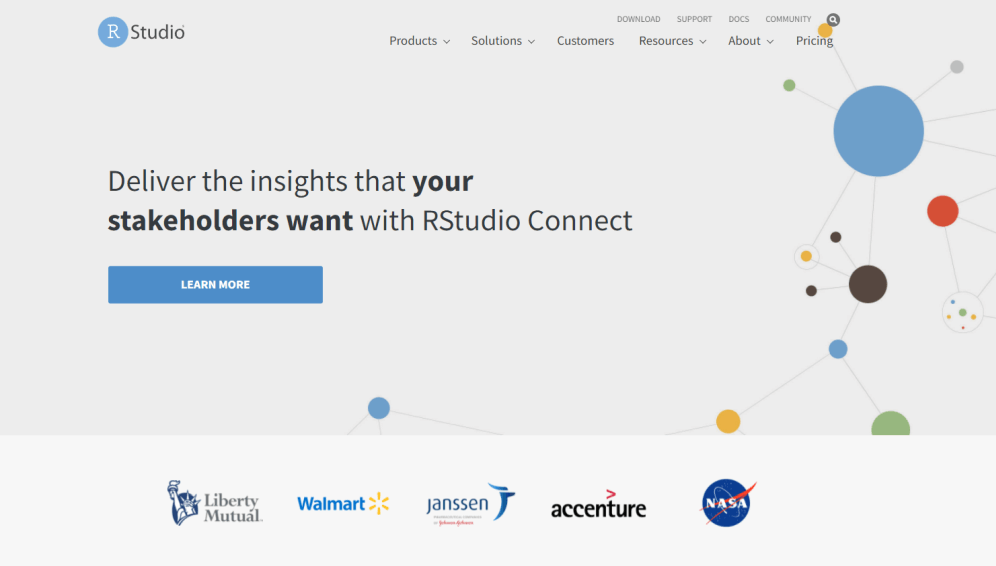
KEY FEATURES:
An ecosystem of more than 10 000 packages and extensions for distinct types of data analysis
Statistical analysis, modeling, and hypothesis testing (e.g. analysis of variance, t test, etc.)
Active and communicative community of researchers, statisticians, and scientists
R is one of the top data analyst tools that is usually referred to as a language designed by statisticians. It's development dates back to 1995 and it's one of the most used tools for statistical analysis and data science, keeping an open- source policy and running on a variety of platforms, including Windows and macOS. RStudio is by far the most popular integrated development environment. R's capabilities for data cleaning, data reduction, and data analysis report output with R markdown, makes this tool an invaluable analytical assistant that covers both general and academic data analysis. It is compiled of an ecosystem of more than 10 000 packages and extensions that you can explore by categories, and perform any kind of statistical analysis such as regression, conjoint, factor cluster analysis, etc. Easy to understand for those that don't have a high-level of programming skills, R can perform complex mathematical operations by using a single command. A number of graphical libraries such as ggplot and plotly make this language different than others in the statistical community since it has efficient capabilities to create quality visualizations.
R was mostly used in the academic area in the past, today it has applications across industries and large companies such as Google, Facebook, Twitter, and Airbnb, among others. Due to an enormous number of researchers, scientists, and statisticians using it, R has an extensive and active community where innovative technologies and ideas are presented and communicated regularly.
3. General-purpose programming languages
Programming languages are used to solve a variety of data problems. We have explained R and statistical programming, now we will focus on general ones that use letters, numbers, and symbols to create programs and require formal syntax used by programmers. Often, they're also called text-based programs because you need to write software that will ultimately solve a problem. Examples include C#, Java, PHP, Ruby, Julia, and Python, among many others on the market. Here we will present Python as one of the best tools for data analysts that have coding knowledge as well.
Python

KEY FEATURES:
An open-source solution that has simple coding processes and syntax so it's fairly easy to learn
Integration with other languages such as C/C++, Java, PHP, C#, etc.
Advanced analysis processes through machine learning and text mining
Python is extremely accessible to code in comparison to other popular languages such as Java, and its syntax is relatively easy to learn making this tool popular among users that look for an open-source solution and simple coding processes. In data analysis, Python is used for data crawling, cleaning, modeling, and constructing analysis algorithms based on business scenarios. One of the best features is actually its user-friendliness: programmers don't need to remember the architecture of the system nor handle the memory – Python is considered a high-level language that is not subject to the computer's local processor.
Another noticeable feature of Python is its portability. Users can simply run the code on several operating systems without making any changes to it so it's not necessary to write completely new code. This makes Python a highly portable language since programmers can run it both on Windows and macOS. An extensive number of modules, packages and libraries make Python a respected and usable language across industries with companies such as Spotify, Netflix, Dropbox and Reddit as the most popular ones that use this language in their operations. With features such as text mining and machine learning, Python is becoming a respected authority for advanced analysis processes.
4. SQL consoles
Our data analyst tools list wouldn't be complete without SQL consoles. Essentially, SQL is a programming language that is used to manage/query data held in relational databases, particularly effective in handling structured data as a database tool for analysts. It's highly popular in the data science community and one of the analyst tools used in various business cases and data scenarios. The reason is simple: as most of the data is stored in relational databases and you need to access and unlock its value, SQL is a highly critical component of succeeding in business, and by learning it, analysts can offer a competitive advantage to their skillset. There are different relational (SQL-based) database management systems such as MySQL, PostgreSQL, MS SQL, and Oracle, for example, and by learning these data analysts' tools would prove to be extremely beneficial to any serious analyst. Here we will focus on MySQL Workbench as the most popular one.
MySQL Workbench
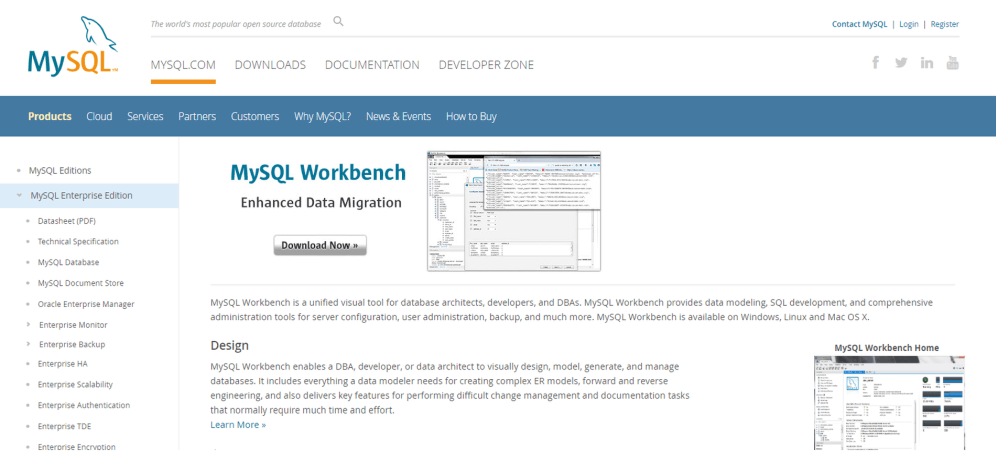
KEY FEATURES:
A unified visual tool for data modeling, SQL development, administration, backup, etc.
Instant access to database schema and objects via the Object Browser
SQL Editor that offers color syntax highlighting, reuse of SQL snippets, and execution history
MySQL Workbench is used by analysts to visually design, model, and manage databases, optimize SQL queries, administer MySQL environments, and utilize a suite of tools to improve the performance of MySQL applications. It will allow you to perform tasks such as creating and viewing databases and objects (triggers or stored procedures, e.g.), configuring servers, and much more. You can easily perform backup and recovery as well as inspect audit data. MySQL Workbench will also help in database migration and is a complete solution for analysts working in relational database management and companies that need to keep their databases clean and effective.
5. Standalone predictive analytics tools
Predictive analytics is one of the advanced techniques, used by analysts that combine data mining, machine learning, predictive modeling, and artificial intelligence to predict future events, and it deserves a special place in our list of data analysis tools as its popularity increases in recent years with the introduction of smart solutions that enabled analysts to simplify their predictive analytics processes. You should keep in mind that some BI tools we already discussed in this list offer easy to use, built-in predictive analytics solutions but, in this section, we focus on standalone, advanced predictive analytics that companies use for various reasons, from detecting fraud with the help of pattern detection to optimizing marketing campaigns by analyzing consumers' behavior and purchases. Here we will list a data analysis software that is helpful for predictive analytics processes and helps analysts to predict future scenarios.
SAS FORECASTING

KEY FEATURES:
Automatic forecasting for a large number of entities or products, including hierarchical forecasting
Scalability and modeling by combining 2 or more models and creating an ensemble
An unlimited model repository that includes time series and casual methods such as ARIMA and ARIMAX
SAS Forecasting for Desktop has established itself as one of the most prominent advanced data analysis software that offers a wide range of forecasting methods, including hierarchical reconciliation, event modeling, what-if analysis, and scenario planning. Their features comprise 7 core areas of forecasting processes, some of them we already mentioned: automatic forecasting, scalability and modeling, unlimited model repository, easy-to-use GUI, event-modeling console, what-if analysis, and data preparation. Based on the variables that you enter in the modeling process, SAS will automatically select variables to generate forecasts to unravel what happens in your business.
Moreover, with a bundle of the SAS Forecast Server, and Visual Forecasting solutions, this data software enables users to produce a large number of forecasts, and automate their processes. Since the company is on the market for decades, they have established themselves as an authority figure in predictive analytics, and it certainly makes sense to give them a try.
6. Data modeling tools
Our list of data analysis tools for analysts wouldn't be complete without data modeling. Creating models to structure the database and design business systems by utilizing diagrams, symbols, and text, ultimately represent how the data flows and is connected in between. Businesses use data modeling tools to determine the exact nature of the information they control and the relationship between datasets, and analysts are critical in this process. If you need to discover, analyze, and specify changes on information that is stored in a software system, database or other application, chances are your skills are critical for the overall business. Here we will show one of the most popular data analyst software used to create models and design your data assets.
erwin data modeler (DM)
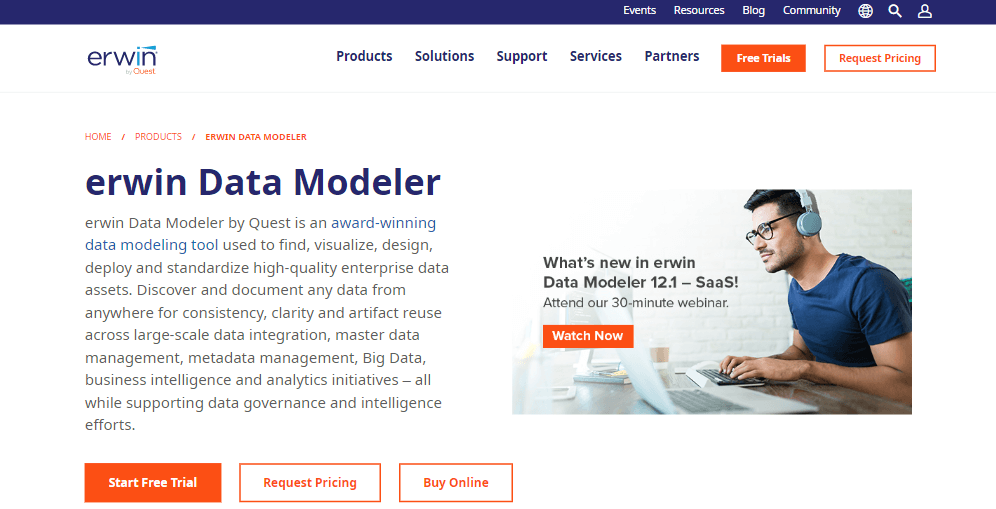
KEY FEATURES:
Automated data model generation to increase productivity in analytical processes
Single interface no matter the location or the type of the data
7 different versions of the solution you can choose from and adjust based on your business needs
erwin DM works both with structured and unstructured data in a data warehouse and in the cloud. It's used to "find, visualize, design, deploy and standardize high-quality enterprise data assets," as stated on their official website. erwin can help you reduce complexities and understand data sources to meet your business goals and needs. They also offer automated processes where you can automatically generate models and designs to reduce errors and increase productivity. This is one of the tools for analysts that focus on the architecture of the data and enable you to create logical, conceptual, and physical data models.
Additional features such as a single interface for any data you might possess, no matter if it's structured or unstructured, in a data warehouse or the cloud makes this solution highly adjustable for your analytical needs. With 7 versions of the erwin data modeler, their solution is highly adjustable for companies and analysts that need various data modeling features.
7. ETL tools
ETL is a process used by companies, no matter the size, across the world, and if a business grows, chances are you will need to extract, load and transform data into another database to be able to analyze it and build queries. There are some core types of ETL tools such as batch ETL, real-time ETL, and cloud based ETL, each with its own specifications and features that adjust to different business needs. These are the tools used by analysts that take part in more technical processes of data management within a company, and one of the best examples is Talend.
Talend
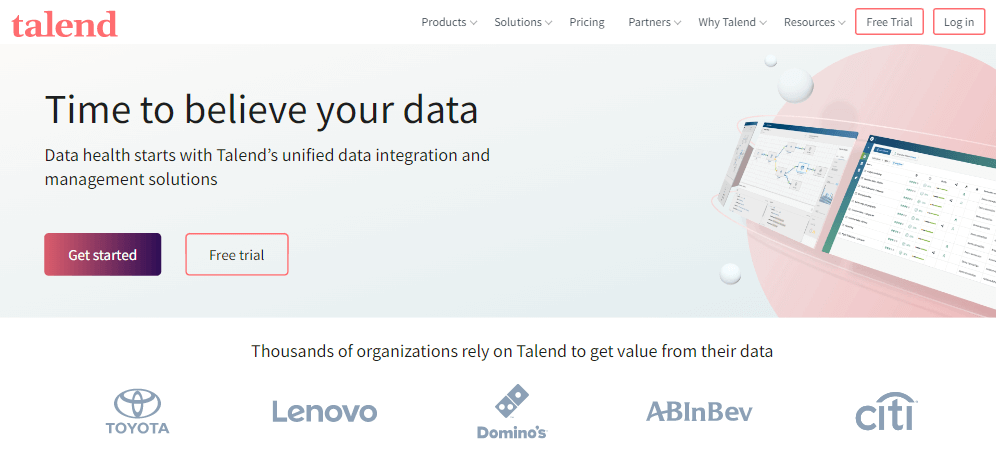
KEY FEATURES:
Collecting and transforming data through data preparation, integration, cloud pipeline designer
Data governance feature to build a data hub and resolve any issues in data quality
Sharing data through comprehensive deliveries via APIs
Talend is a data integration platform used by experts across the globe for data management processes, cloud storage, enterprise application integration, and data quality. It's a Java-based ETL tool that is used by analysts in order to easily process millions of data records, and offers comprehensive solutions for any data project you might have. Talend's features include (big) data integration, data preparation, cloud pipeline designer, and stitch data loader to cover multiple data management requirements of an organization. This is an analyst software extremely important if you need to work on ETL processes in your analytical department.
Apart from collecting and transforming data, Talend also offers a data governance solution to build a data hub and deliver it through self-service access through a unified cloud platform. You can utilize their data catalog, inventory and produce clean data through their data quality feature. Sharing is also part of their data portfolio; Talend's data fabric solution will enable you to deliver your information to every stakeholder through a comprehensive API delivery platform. If you need a data analyst tool to cover ETL processes, Talend might be worth considering.
8. Automation Tools
As mentioned, the goal of all the solutions present on this list is to make data analysts life's easier and more efficient. Taking that into account, automation tools could not be left out of this list. In simple words, data analytics automation is the practice of using systems and processes to perform analytical tasks with almost no human interaction. In the past years, automation solutions have impacted the way analysts perform their jobs as these tools assist them in a variety of tasks such as data discovery, preparation, data replication, and more simple ones like report automation or writing scripts. That said, automating analytical processes significantly increases productivity, leaving more time to perform more important tasks. We will see this more in detail through Jenkins one of the leaders in open-source automation tools.
JENKINS

KEY FEATURES:
popular continuous integration (CI) solution with advanced automation features such as running code in multiple platforms
Job automations to set up customized tasks can be scheduled or based on a specific event
Several job automation plugins for different purposes such as Jenkins Job Builder, Jenkins Job DLS or Jenkins Pipeline DLS
Developed in 2004 under the name Hudson, Jenkins is an open-source CI automation server that can be integrated with several DevOps tools via plugins. By default, Jenkins assists developers to automate parts of their software development process like building, testing, and deploying. However, it is also highly used by data analysts as a solution to automate jobs such as running codes and scripts daily or when a specific event happened. For example, run a specific command when new data is available.
There are several Jenkins's plugins to generate jobs automatically. For example, the Jenkins Job Builder plugin takes simple descriptions of jobs in YAML or JSON format and turns them into runnable jobs in Jenkins's format. On the other side, the Jenkins Job DLS plugin provides users with the capabilities to easily generate jobs from other jobs and edit the XML configuration to supplement or fix any existing elements in the DLS. Lastly, the Pipeline plugin is mostly used to generate complex automated processes.
For Jenkins, automation is not useful if it's not tight to integration. For this reason, they provide hundreds of plugins and extensions to integrate Jenkins with your existing tools. This way, the entire process of code generation and execution can be automated at every stage and in different platforms - leaving analysts enough time to perform other relevant tasks. All the plugins and extensions from Jenkins are developed in Java meaning the tool can also be installed in any other operator that runs on Java.
9. Unified data analytics engines
If you work for a company that produces massive datasets and needs a big data management solution, then unified data analytics engines might be the best resolution for your analytical processes. To be able to make quality decisions in a big data environment, analysts need tools that will enable them to take full control of their company's robust data environment. That's where machine learning and AI play a significant role. That said, Apache Spark is one of the data analysis tools on our list that supports big-scale data processing with the help of an extensive ecosystem.
Apache Spark
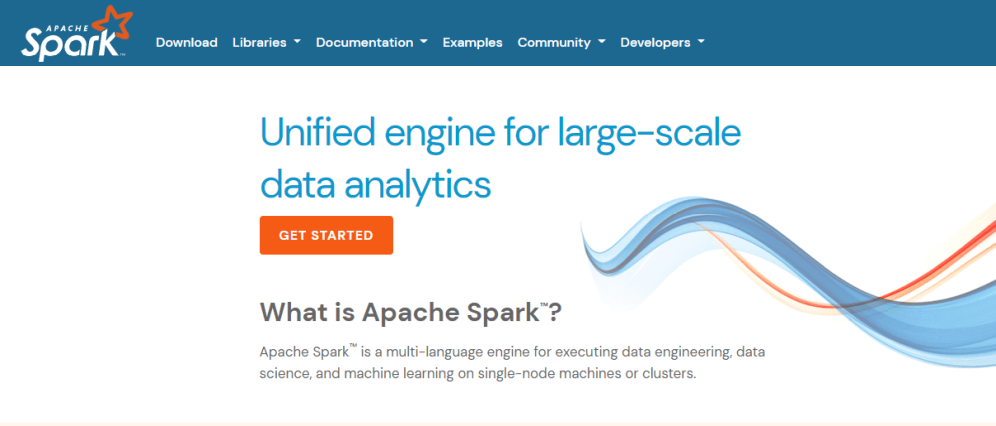
KEY FEATURES:
High performance: Spark owns the record in the large-scale data processing
A large ecosystem of data frames, streaming, machine learning, and graph computation
A collection of over 100 operators for transforming and operating on large scale data
Apache Spark is originally developed by UC Berkeley in 2009 and since then, it has expanded across industries and companies such as Netflix, Yahoo, and eBay that have deployed Spark, processed petabytes of data and proved that Apache is the go-to solution for big data management. Their ecosystem consists of Spark SQL, streaming, machine learning, graph computation, and core Java, Scala, and Python APIs to ease the development. Already in 2014, Spark has officially set a record in large-scale sorting. Actually, the engine can be 100x faster than Hadoop and this is one of the features that is extremely crucial for massive volumes of data processing.
You can easily run applications in Java, Python, Scala, R, and SQL while more than 80 high-level operators that Spark offers will make your data transformation easy and effective. As a unified engine, Spark comes with support for SQL queries, MLlib for machine learning and GraphX for streaming data that can be combined to create additional, complex analytical workflows. Additionally, it runs on Hadoop, Kubernetes, Apache Mesos, standalone or in the cloud and can access diverse data sources. Spark is truly a powerful engine for analysts that need support in their big data environment.
10. Spreadsheet applications
Spreadsheets are one of the most traditional forms of data analysis. Quite popular in any industry, business or organization, there is a slim chance that you haven't created at least one spreadsheet to analyze your data. Often used by people that don't have high technical abilities to code themselves, spreadsheets can be used for fairly easy analysis that doesn't require considerable training, complex and large volumes of data and databases to manage. To look at spreadsheets in more detail, we have chosen Excel as one of the most popular in business.
Excel
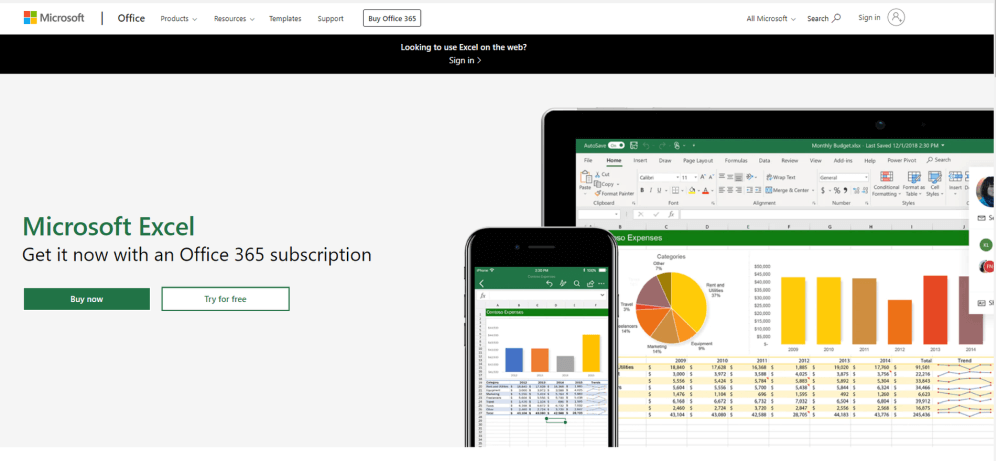
KEY FEATURES:
Part of the Microsoft Office family, hence, it's compatible with other Microsoft applications
Pivot tables and building complex equations through designated rows and columns
Perfect for smaller analysis processes through workbooks and quick sharing
Excel needs a category on its own since this powerful tool has been in the hands of analysts for a very long time. Often considered as a traditional form of analysis, Excel is still widely used across the globe. The reasons are fairly simple: there aren't many people who have never used it or came across it at least once in their career. It's a fairly versatile data analyst tool where you simply manipulate rows and columns to create your analysis. Once this part is finished, you can export your data and send it to the desired recipients, hence, you can use Excel as a report tool as well. You do need to update the data on your own, Excel doesn't have an automation feature similar to other tools on our list. Creating pivot tables, managing smaller amounts of data and tinkering with the tabular form of analysis, Excel has developed as an electronic version of the accounting worksheet to one of the most spread tools for data analysts.
A wide range of functionalities accompany Excel, from arranging to manipulating, calculating and evaluating quantitative data to building complex equations and using pivot tables, conditional formatting, adding multiple rows and creating charts and graphs – Excel has definitely earned its place in traditional data management.
11. Industry-specific analytics tools
While there are many data analysis tools on this list that are used in various industries and are applied daily in analysts' workflow, there are solutions that are specifically developed to accommodate a single industry and cannot be used in another. For that reason, we have decided to include of one these solutions on our list, although there are many others, industry-specific data analysis programs and software. Here we focus on Qualtrics as one of the leading research software that is used by over 11000 world's brands and has over 2M users across the globe as well as many industry-specific features focused on market research.
QUALTRICS
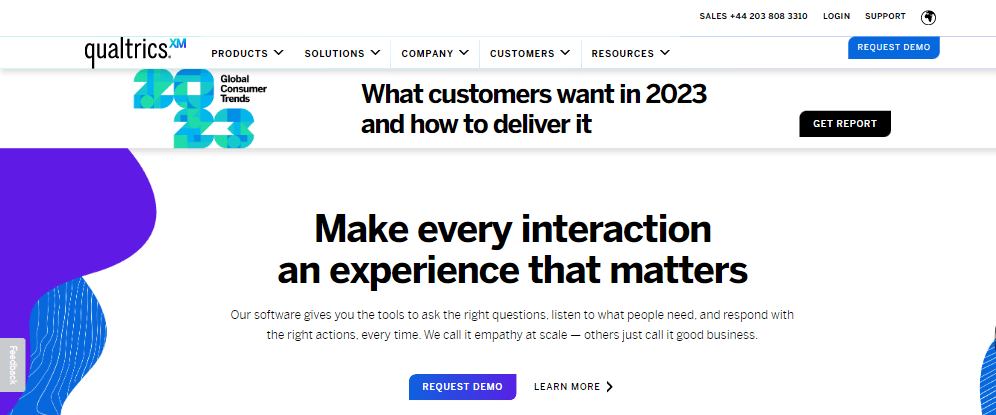
KEY FEATURES:
4 main experience features: customer, brand, employee, and product
Additional research services by their in-house experts
Advanced statistical analysis with their Stats iQ analysis tool
Qualtrics is a software for data analysis that is focused on experience management and is used for market research by companies across the globe. They offer 4 product pillars: the customer experience, brand, employee, and product experience, and additional research services performed by their own experts. Their XM platform consists of a directory, automated actions, Qualtrics iQ tool, and platform security features that combine automated and integrated workflows into a single point of access. That way, users can refine each stakeholder's experience and use their tool as an "ultimate listening system."
Since automation is becoming increasingly important in our data-driven age, Qualtrics has also developed drag-and-drop integrations into the systems that companies already use such as CRM, ticketing, or messaging, while enabling users to deliver automatic notifications to the right people. This feature works across brand tracking and product feedback as well as customer and employee experience. Other critical features such as the directory where users can connect data from 130 channels (including web, SMS, voice, video, or social), and Qualtrics iQ to analyze unstructured data will enable users to utilize their predictive analytics engine and build detailed customer journeys. If you're looking for a data analytic software that needs to take care of market research of your company, Qualtrics is worth the try.
12. Data science platforms
Data science can be used for most software solutions on our list, but it does deserve a special category since it has developed into one of the most sought-after skills of the decade. No matter if you need to utilize preparation, integration or data analyst reporting tools, data science platforms will probably be high on your list for simplifying analytical processes and utilizing advanced analytics models to generate in-depth data science insights. To put this into perspective, we will present RapidMiner as one of the top data analyst software that combines deep but simplified analysis.
RapidMiner
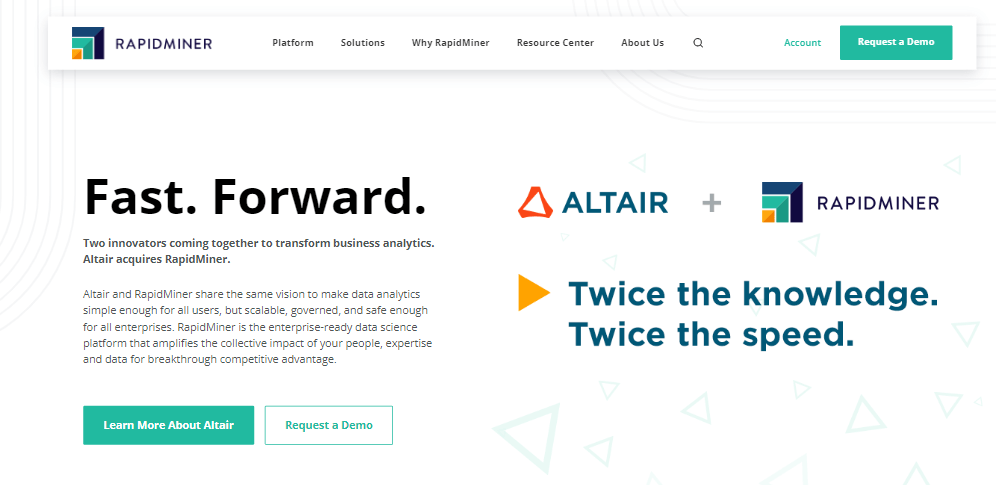
KEY FEATURES:
A comprehensive data science and machine learning platform with more than 1500 algorithms
Possible to integrate with Python and R as well as support for database connections (e.g. Oracle)
Advanced analytics features for descriptive and prescriptive analytics
RapidMiner is a tool used by data scientists across the world to prepare data, utilize machine learning and model operations in more than 40 000 organizations that heavily rely on analytics in their operations. By unifying the entire data science cycle, RapidMiner is built on 5 core platforms and 3 automated data science products that help in the design and deploy analytics processes. Their data exploration features such as visualizations and descriptive statistics will enable you to get the information you need while predictive analytics will help you in cases such as churn prevention, risk modeling, text mining, and customer segmentation.
With more than 1500 algorithms and data functions, support for 3rd party machine learning libraries, integration with Python or R, and advanced analytics, RapidMiner has developed into a data science platform for deep analytical purposes. Additionally, comprehensive tutorials and full automation, where needed, will ensure simplified processes if your company requires them, so you don't need to perform manual analysis. If you're looking for analyst tools and software focused on deep data science management and machine learning, then RapidMiner should be high on your list.
13. DATA CLEANSING PLATFORMS
The amount of data being produced is only getting bigger, hence, the possibility of it involving errors. To help analysts avoid these errors that can damage the entire analysis process is that data cleansing solutions were developed. These tools help analysts prepare their data by eliminating errors, inconsistencies, and duplications enabling them to extract accurate conclusions from the data. Before cleansing platforms were a thing, analysts would manually clean the data, this is also a dangerous practice since the human eye is prompt to error. That said, powerful cleansing solutions have proved to boost efficiency and productivity while providing a competitive advantage as data becomes reliable. The cleansing software we picked for this section is a popular solution named OpenRefine.
OpenRefine
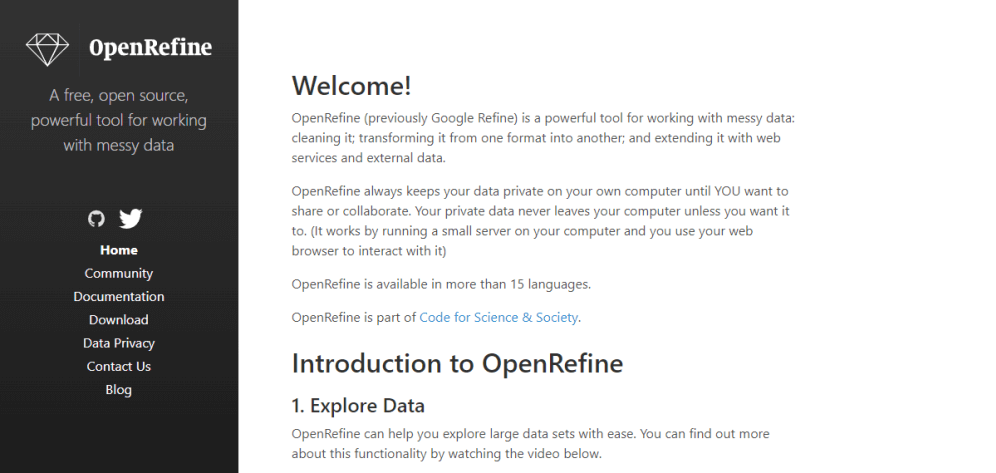
KEY FEATURES:
Data explorer to clean "messy" data using transformations, facets, clustering, among others
Transform data to the format you desire, for example, turn a list into a table by importing the file into OpenRefine
Includes a large list of extensions and plugins to link and extend datasets with various web services
Previously known as Google Refine, OpenRefine is a Java-based open-source desktop application for working with large sets of data that needs to be cleaned. The tool also enables users to transform their data from one format to another and extend it with web services and external data. OpenRefine has a similar interface to the one of spreadsheet applications and can handle CSV file formats, but all in all, it behaves more as a database. Upload your datasets into the tool and use their multiple cleaning features that will let you spot anything from extra spaces to duplicated fields.
Available in more than 15 languages, one of the main principles of OpenRefine is privacy. The tool works by running a small server on your computer and your data will never leave that server unless you decide to share it with someone else.
14. Data visualization tools & platforms
Data visualization has become one of the most indispensable elements of data analytics tools. If you're an analyst, there is probably a strong chance you had to develop a visual representation of your analysis or utilize some form of data visualization. Here we need to make clear that there are differences between professional data visualization tools often integrated through already mentioned BI tools, free available solutions as well as paid charting libraries. They're simply not the same. Also, if you look at data visualization in a broad sense, Excel and PowerPoint also have it on offer, but they simply cannot meet the advanced requirements of a data analyst who usually chooses professional BI or data viz tools as well as modern charting libraries, as mentioned. We will take a closer look at Highcharts as one of the most popular charting libraries on the market.
Highcharts
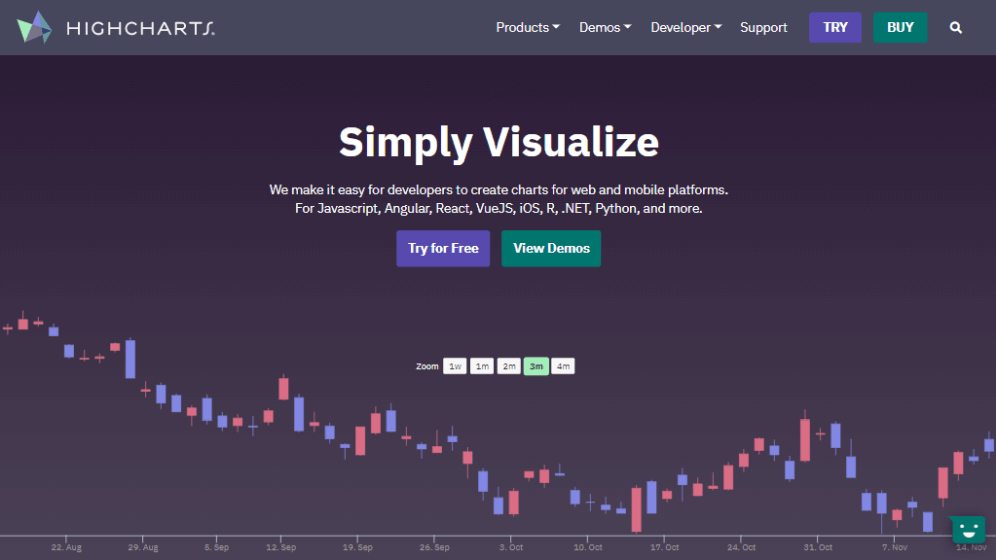
KEY FEATURES:
Interactive JavaScript engine for charts used in web and mobile projects
Designed mostly for a technical-based audience (developers)
WebGL-powered boost module to render millions of datapoints directly in the browser
Highcharts is a multi-platform library that is designed for developers looking to add interactive charts into web and mobile projects. This charting library works with any back-end database and data can be given in CSV, JSON or updated live. They also feature intelligent responsiveness that fits the desired chart into the dimensions of the specific container but also places non-graph elements in the optimal location automatically.
Highcharts supports line, spline, area, column, bar, pie, scatter charts and many others that help developers in their online-based projects. Additionally, their WebGL-powered boost module enables you to render millions of datapoints in the browser. As far as the source code is concerned, they allow you to download and make your own edits, no matter if you use their free or commercial license. In essence, Basically, Highcharts is designed mostly for the technical target group so you should familiarize yourself with developers' workflow and their JavaScript charting engine. If you're looking for a more easy to use but still powerful solution, you might want to consider an online data visualization tool like datapine.
3) Key Takeaways & Guidance
We have explained what are data analyst tools and gave a brief description of each to provide you with insights needed to choose the one (or several) that would fit your analytical processes the best. We focused on diversity in presenting tools that would fit technically skilled analysts such as R Studio, Python, or MySQL Workbench. On the other hand, data analysis software like datapine cover needs both for data analysts and business users alike so we tried to cover multiple perspectives and skill levels.
We hope that by now you have a clearer perspective into how modern solutions can help analysts perform their jobs more efficiently in a less prompt to error environment. To conclude, if you want to start an exciting analytical journey and test a professional BI analytics software for yourself, you can try datapine for a 14-day trial, completely free of charge and with no hidden costs.
Source: https://www.datapine.com/articles/data-analyst-tools-software
0 Response to "Easy Analytic Software"
Post a Comment